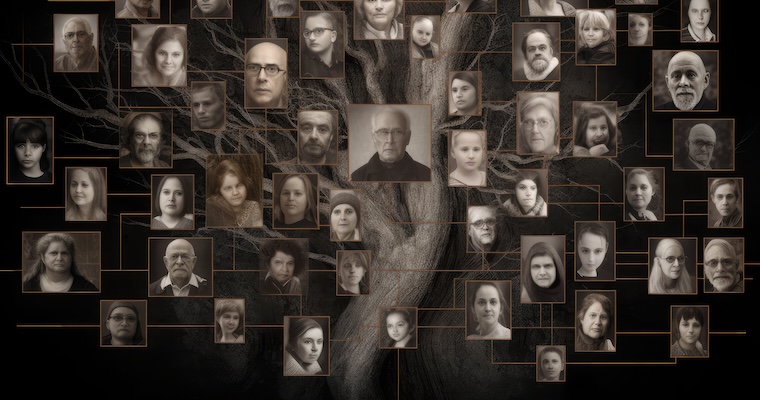Family History Can Be Repurposed to Serve Today's Challenges

The stories that families tell about their past matter. Here are some ways that families can begin to use the past to serve their present-day goals.
EDITOR’S NOTE: This article was produced in partnership with Family Business Review, a leading journal in the field of family business, as part of FamilyBusiness.org's mission to bring research-proven insights and practical advice to our readers.
Family firms often frame their history as a tale of generations (e.g., first, second, third – generation). This approach has become so ingrained in how we think about family and organizational histories that it often goes unquestioned. However, family businesses and their advisors might be surprised to discover that the seemingly casual way they speak about the past holds strategic significance. We’ve explored how families engage in the “strategic use of the past” by using four distinct ways to talk about “generation” to influence stakeholders to support the family business. We’ve seen that storytelling “by generation” is a way to continue or change past traditions and behaviors.
What We Studied
We studied a private German printing and publishing company in its seventh generation. Founded in 1801, the company has a detailed and accessible archive that includes many narratives and stories about the past. We delved into its rich family and business archives and studied 2,710 binders of documents and 319 photos in 246 archival boxes. We added interviews with the current family business CEO, his successor, and other employees, along with information gleaned from the firm’s in-house magazine.
What We Found
We were surprised to find how diverse the usages of “generation” are in a family business and how meaningful the differences are for strategic storytelling—that is, how we use stories about the past to fashion a vision for how and why the family business will succeed in the future. We identified four distinct uses of the term “generation,” each providing different ways to link the past, present, and future. These usages can be categorized into two groups: those that emphasize continuity and those that emphasize change. When emphasizing continuity, the intention is to utilize key stories from the past to extend critical ways the family business operates internally and in the broader community. When emphasizing change, the intention is to utilize key stories from the past to develop new ways for the family business to innovate.
Here are the four ways that “generation” is used to depict the family business story.
Generation as Lineage
This use highlights the continuity of generations within the family by underscoring the passing of leadership and values from one generation to the next, reinforcing a sense of stability and tradition.
In the family we studied, stories about the family CEOs repeatedly refer to the gapless genealogical lineage that the owner-managers belonged to, both in words (“continue in the sense that has carried us over many generations,” “Six generations of the … family have contributed to such a success”) and in metaphors (“a link in a chain of generations,” “the tree” that allows “future generations [to] do creative work”). For example, upon the death of the family business CEO, his short, official obituary notice stressed only one theme: generational lineage. “It was granted to him to preserve the legacy of his fathers in more than 25 years of work.” In connecting past, present and future, one manager argued,
"There is no better way to preserve his legacy than to continue the work in his sense . . . This happens with all the more confidence given that the sixth generation, his son is already with us..."
By linking stories about how past family CEOs have successfully managed the company, the intention is to show stakeholders that continuing these past efforts will enable the family business to thrive.
Generation as Myth
This type of storytelling embeds the family business within a larger, enduring story, enhancing its legitimacy and gravitas. Our family frequently referenced the much older craft tradition of the printing and publishing industry. To enhance the legitimacy of the business, narrators regularly connected the company to this mythical story in narratives and social practices. For example, when the family celebrated a new building for the company in December 1961, they buried a paper under the doorstep in accordance with craft traditions. It read:
“In the Year of the Lord 1961
In the 517th year since the invention of Master Gutenberg
In the 161st year since Johann Peter … founded the company in Wesel
Laid the bearers of the fifth generation … the cornerstone of the new printing house in Mönchengladbach
Remembering the obligation towards the work of the ancestors
Boldly advancing forward in the service of future generations.” (33-8).
By dating the new building to Johan Gutenberg's invention of printing, the tradition of craft printing became linked to the family business. Generation as myth highlights the continuity of the family business by connecting to deeply rooted, respected, and frequently remembered societal institutions.
Generation as Reinvention
This messaging illustrates change in the roles and tasks within the family. It focuses on how each generation reinvents its approach to business, reflecting adaptability and innovation in response to internal and external changes.
For example, in his first speech to management after his father died in 1965, one family firm leader pleaded not to get “caught up in tradition” and “be alert!” Asking for the managers’ support when reinventing, he stated: “It is therefore important, ladies and gentlemen, that you too help me to be on my guard and intervene if you believe that clear economic thinking is overshadowed by too much tradition.” One decade later, he argued in front of his employees that “each generation has its own problems.” And reminiscent of his father’s earlier words, he added, "Each of my ancestors had the skill and the will to be a new beginning, to see tradition not as a burden, but as an obligation to fill it with new life for another generation.” By reframing what tradition means to him, the son created a space for reinventing his role in the business and family.
Generation as Critique
This use positions the family to engage with major societal change. It highlights how family businesses respond to emerging opportunities or novel threats, positioning the firm as dynamic and responsive to the broader socio-economic environment.
For example, one family business leader looked back and highlighted the difference between what he considered his generation and the previous one: “I started at a time when major changes in the state and society were on the horizon. The times in which our thoughts and actions were shaped by reconstruction have gradually been replaced by an era in which questions about the structure of society and its changes took over.”
This approach also reflects how some anecdotes evolve and get repurposed when new challenges arise, especially when they are part of a message of caution. Out of several cautionary tales about the family business, the one most frequently repeated refers to 1921, when the family CEO turned the family business into a joint stock company during a time of German hyperinflation. The official anniversary book of 1951, 30 years after the events, recounts,
"(He) soon recognized the danger that this anonymous form of company . . . brought with it for keeping the company in family ownership. He succeeded in mastering the incipient foreign infiltration . . . by gradually buying back these shares."
This cautionary tale was frequently repeated, yet its moral evolved. It changed over time as it connected in different ways with the present challenges. By the 1960s, the family CEO reminded the leading managers of how the knowledge of the share buy-back had shaped his upbringing.
"I would like to say that a family company occupies a special place among the most diverse forms of today’s entrepreneurial world. Independent entrepreneurship shaped the generation before me. . . . My upbringing was determined by the idea that I, too, can survive as an independent entrepreneur in such an expansive, financially strong economy."
Over time, the tale evolves from a word of warning about growth through equity financing to a strategic principle of keeping the ownership of the business completely within the family.
Table 1: Four Uses of Generation in Family Business Narratives

In essence, how family businesses talk about their past influences how they are perceived in the present and how they plan for the future. By being mindful of the different generational narratives at their disposal, family business leaders can craft stories that resonate deeply with their stakeholders and support their long-term success. Depending on their goals and the context in which they operate, they can emphasize continuity or change. This strategic use of storytelling helps communicate the business’s vision and values and legitimizes and shapes its future direction.
Takeaways for Family Businesses
Our research identifies different uses of the term “generation,” which coexist and create room for greater flexibility in managing a family business’s history. The stories that families tell about their past matter. Here are some ways that families can begin to use the past to serve their present-day goals.
- Think about how you talk about the past. Consciously identify the stories they use (and the stories others tell about the family business) to generate an inventory of examples of whether these stories emphasize continuity with the past or work to offer suggestions for how the family business changes over time.
- Consider which stories resonate with stakeholders and determine what purpose each of these stories serves.
- Continuity stories, which focus on how certain business family activities, values, strategies, and traditions persist over time, are worth keeping when these past practices and traditions continue to solve present problems. We suggest this aphorism: “Traditions are solutions to yesterday’s problems” as the key to considering whether to maintain the value of the past or change it. If today’s problems are similar to yesterday’s, keeping the past as a guide will be beneficial.
- Change stories, which focus on how actors in the past made strategic adjustments to prior business family activities, values, strategies, and traditions, can demonstrate how change has occurred in the past as part of the business family's success over time.
- As this study's history of the printing business demonstrates, business families constantly navigate between continuity and change, so stories of the past are critical for providing a foundation for enabling the business family to move forward into the future.
- Understanding the various ways that “generation” can be used in storytelling highlights that how we narrate history is just as important as the stories themselves. As our example in the “Generation as Critique” showed, stories of the past can be refashioned to serve current purposes.
By integrating these insights, family business practitioners can become more deliberate and reflective about their storytelling practices. They can use the generational narrative to preserve tradition and promote innovation. This strategic use of storytelling strengthens the business’s legacy and supports its ongoing evolution and success. “The generation tale” is effective because it connects family genealogy to broader societal developments, linking past, present, and future in a way that helps balance the need for both change and continuity—one of the major challenges in family businesses.
Explore the Research
Lubinski, C., & Gartner, W. B. (2023). Talking About (My) Generation: The Use of Generation as Rhetorical History in Family Business. Family Business Review, 36(1), 119-142.


Bertarelli Foundation Distinguished Professor of Family Entrepreneurship / Entrepreneurship / Babson College
View Profile




